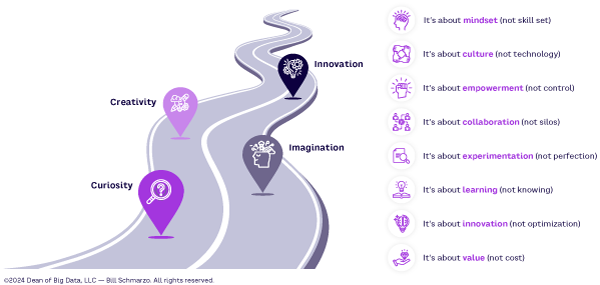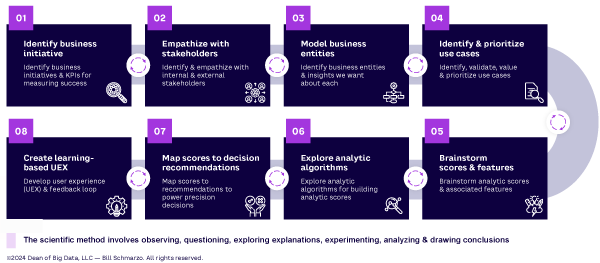AMPLIFY VOL. 37, NO. 6

In today’s rapidly evolving technological landscape, discussions often pivot quickly to the financial benefits — particularly cost reductions — that new technologies like AI and generative AI (GenAI) can offer. For instance, senior executives are fascinated with how GenAI can improve productivity and reduce customer service costs; this viewpoint echoes a widespread corporate desire to equate technological adoption with direct financial savings. However, this perspective only scratches the broader, more impactful economic potential of these technologies.
As economist/philosopher Adam Smith illuminated in his seminal work, The Wealth of Nations, the essence of economics is the creation, consumption, and distribution of wealth — or value.1 While financial metrics focus on the ledger, counting pennies saved or spent, economics paints with a broader brush, exploring how technologies like AI/GenAI can catalyze new forms of value creation. This value can take the form of innovative customer experiences, enhanced product features, streamlined service models, and/or operational efficiencies that elevate the economic standing of enterprises and societies alike.
“Economic innovation” refers to the introduction of new products, services, processes, or policies that enhance an organization’s financial health, efficiency, or economic growth. For example, rather than a tool for reducing costs and increasing productivity, GenAI can be a pivotal technology that drives economic value creation across various sectors. It can catalyze business model creation and a variety of market opportunities, creating economic value.
As we delve into the economic impact of new technologies like AI/GenAI, we see that their true value lies in their ability to redefine markets, enhance competitiveness, and spawn new economic ecosystems. This article explores how shifting our focus from a financial to an economic lens (not just counting costs but generating value) can radically alter our appreciation and application of groundbreaking technologies.
Cultural Empowerment Fuels Economic Innovation
Centralizing innovation to a select few “experts” limits an organization’s potential to benefit from capabilities like AI/GenAI. Everyone in the organization must have a stake in innovation, especially frontline workers engaged in customer service and operations.
These individuals have valuable knowledge about where and how to apply innovative technologies to create new sources of customer, product, service, and operational value. They should provide feedback on the effectiveness of the analytics used to optimize customer engagement and operational execution, and that feedback should be used to update and refine the AI models (known as “reinforcement learning from human feedback” or RLHF). If you want full adoption of AI results, start by involving these folks in the definition, development, deployment, and refinement of the analytics they will use in their daily interactions. Economic innovation starts with cultural empowerment.
Cultural empowerment fosters an inclusive environment that values everyone’s contributions and equips them with tools for innovation. The critical characteristics of cultural empowerment, particularly in the context of leveraging AI/GenAI for economic innovation, include:
-
Exploration — drives innovation, especially with emerging technologies like AI/GenAI, which require experimentation to realize their full potential. Encouraging curiosity and pursuing knowledge and solutions without fearing failure is crucial to exploration.
-
Intelligent risk-taking — involves making calculated decisions to pursue potentially beneficial innovations despite uncertain outcomes. It is supported by data-driven insights and a deep understanding of the potential rewards and risks involved.
-
Continuous learning and adapting — represents essential qualities that highlight the significance of learning new technologies, business strategies, and market conditions. In the context of AI/GenAI, individuals should regularly update their skills and understanding to keep up with technological advancements and their business applications.
-
Transparency — fosters trust and inclusiveness, allowing individuals to understand the rationale behind decisions, including AI-driven ones. It encourages a collaborative environment where the potential and limitations of AI/GenAI are openly discussed, ensuring that all stakeholders are on the same page.
-
Empathy and human-centric design — begin with understanding the human impact of AI/GenAI and designing solutions that address fundamental human needs. It is essential to ensure that technological innovation is aligned with improving the human condition, leading to solutions that are not only economically viable but also socially responsible.
-
An adaptive mindset — is crucial to the ability to learn, unlearn, and relearn as circumstances change. In an AI-enhanced world, this means pivoting and adjusting strategies as new information and technologies emerge.
-
Inclusivity and diversity — involve diverse voices in the development and deployment of AI/GenAI, which ensures that a broad range of experiences and perspectives are considered, leading to more innovative and equitable solutions.
-
Resilience — the capacity to recover from setbacks and persist in the face of challenges is critical when working with emerging technologies. It ensures that organizations can sustain innovation efforts through the inevitable ups and downs of technology adoption.
-
AI literacy — consists of understanding and interpreting data, which is increasingly vital in an AI-driven world. Cultivating data literacy across the organization enables more members to meaningfully participate in, and contribute to, AI initiatives.
-
Ethical consideration — is the heart of AI/GenAI. As they become more integrated into organizational processes, the ethical implications of their use must be considered. A culture that prioritizes ethical considerations will navigate the complexities of AI/GenAI more successfully and sustainably.
Encouraging empowerment throughout your organization can unlock your employees’ collective creativity and knowledge, leading to more ideas about where and how AI/GenAI can develop solutions to drive your organization’s economic innovation. That means senior management must invest in cultural empowerment and create a culture that exploits the natural human characteristics of curiosity and imagination.
Imagine a path that represents the journey toward cultural empowerment and innovation. This path starts with a base of curiosity and ends with the peak of innovation (see Figure 1). Figure 1 shows how cultural empowerment can inspire human curiosity and exploration, leading to genuine creativity and economic innovation. To achieve this human-driven economic innovation, we must promote a culture that embraces AI/GenAI for innovation, including:
-
Curiosity. At the start of the journey, curiosity represents the foundational attitude that drives individuals to question the status quo and seek knowledge. In the context of AI/GenAI, fostering curiosity in all team members ensures a constant search for data insights and innovative technology applications.
-
Imagination. Building on curiosity, imagination allows individuals to conceptualize novel ways to apply AI/GenAI. It’s about seeing beyond current applications to imagine future innovations.
-
Creativity. This level represents the synthesis of curiosity and imagination, turning new ideas into tangible concepts. In AI/GenAI, this might manifest as inventive data models, unique algorithms, or original ways to integrate AI into products and services.
-
Innovation. At the pinnacle, empowerment and encouragement of exploration, intelligent risk-taking, and continuous learning result in new AI-driven products, services, or operational processes that deliver economic value.

Think Like a Data Scientist
Having established the economic imperative of shifting our focus from cost-cutting to value creation, we now need a collaborative, design-centric, human-empowered framework that can help organizations leverage AI to create new sources of customer, product, service, and operational value. Welcome to the “Thinking Like a Data Scientist” (TLADS) methodology (see Figure 2).2,3 TLADS integrates design thinking, data science, and data economics to enhance decision-making and redefine how we perceive and capitalize on business opportunities. It is built on the following three fundamentals.4

1. Design Thinking Fuels Imagination & Innovation
With its core emphasis on user-centric problem-solving, design thinking plays a pivotal role in maximizing GenAI’s potential. It prompts organizations to think beyond traditional boundaries, fostering an environment where innovation is encouraged and inevitable. By applying design thinking to AI development, companies can create solutions that are not only technologically feasible but also profoundly aligned with fundamental human needs and market demands. This alignment is crucial for developing AI-driven products and services that resonate with users and deliver sustainable economic value.5
2. Data Science Is the Backbone of Scaling Innovation
Data science is central to unlocking AI’s economic potential. The rigorous analytical processes and advanced modeling techniques in data science help businesses extract actionable insights from vast amounts of data. By systematically applying data science principles, organizations can predict trends, personalize customer experiences, and optimize operations — each an avenue for significant economic innovation. Moreover, data science ensures that AI initiatives are based on empirical evidence, enhancing their credibility in driving business value.
3. Data Economics Drives Sustainable Value Creation
Data economics provides the framework for understanding and quantifying data’s value to business processes. In the context of AI, this means identifying how information assets can be transformed into economic gains. By applying data economics principles, organizations can measure the impact of data reuse, sharing, and innovation on their economic performance. This approach (1) helps maximize the ROI from data assets and (2) aids in crafting strategies that leverage AI for increased revenue and competitive advantage.
These fundamentals lay the groundwork for businesses to explore and navigate the complexities of deploying AI to deliver more accurate and meaningful outcomes. The synergy among these disciplines encourages a holistic view of AI’s role within the business ecosystem, emphasizing sustainable value creation over short-term gains. This allows companies to adapt to the evolving economic landscape and drive forward-thinking innovations that redefine their industries.6
GenAI Is an Economic Innovation Force Multiplier
A force multiplier is a factor or tool that dramatically increases the effectiveness of an effort or system, enabling significantly more effective results with the same level of input.
Integrating GenAI tools such as ChatGPT with the TLADS methodology provides a force multiplier that can accelerate and expand economic innovation within organizations. By combining GenAI’s cutting-edge capabilities with the structured, holistic approach of TLADS, organizations can unlock the creative potential of AI. This integration can transform economic innovation efforts in several ways:
-
Automated data exploration. GenAI can automate the exploration of vast data sets, identifying patterns and insights that might not be immediately apparent to human analysts. This can accelerate the discovery and creation of machine learning (ML) features that are critical to building relevant, accurate AI/ML models
-
Predictive modeling and scenario simulation. With GenAI, organizations can develop predictive models and simulate business scenarios with greater accuracy and less human bias. This capability supports more effective data-driven decision-making, which helps executives uncover new sources of customer, product, service, and operational value.
-
Rapid prototyping. GenAI can generate prototypes of new products, services, or business models, allowing teams to quickly test and iterate. This highlights the importance of experimentation and validation in ensuring that ideas are innovative and viable.
-
User-centric design. Leveraging GenAI in design thinking processes facilitates the creation of more personalized and adaptive user experiences. Organizations can continuously refine and enhance their offerings by integrating user feedback directly into the AI model training process, ensuring they meet evolving customer needs effectively.
-
Democratization of data and AI tools. By making advanced AI tools accessible to non-experts, GenAI empowers a broader range of employees to engage with data science practices. This fosters a culture of innovation and collaboration that encourages a more inclusive approach to problem-solving.
-
Continuous learning and adaptation. Integrating GenAI facilitates a culture of constant learning and adaptation, which is essential for staying competitive in dynamic markets. GenAI tools provide real-time insights and updates, enabling organizations to pivot quickly and efficiently in response to new information or market conditions.
By combining GenAI with TLADS, organizations can accelerate their current economic innovation efforts and expand their capacity to explore new opportunities for growth and value creation. This synthesis drives more effective and efficient innovation processes and embeds a sustainable, forward-thinking mindset across the organization.
References
1 “The Works of Adam Smith.” Adam Smith Institute, accessed June 2024.
2 Schmarzo, Bill. The Art of Thinking Like a Data Scientist. Dean of Big Data, 2024.
3 The second edition of the TLADS methodology introduces several improvements over the original version, focusing on a deeper integration with AI capabilities. It enhances guidance on leveraging big data and AI technologies to refine decision-making processes, ensuring that data-driven insights are more actionable and directly aligned with strategic business goals. The updated edition also expands on collaborative tools and techniques, facilitating greater cross-departmental collaboration and innovation, which are crucial for implementing a data-centric culture within organizations.
4 Dennehy, Denis, Bill Schmarzo, and Mouwafac Sidaoui. “Organising for AI-Powered Innovation Through Design: The Case of Hitachi Vantara.” International Journal of Technology Management, Vol. 88, No. 2-4, 2022.
5 Schmarzo, Bill, and Mouwafac Sidaoui. “Applying Economic Concepts to Big Data to Determine the Financial Value of the Organization’s Data and Analytics, and Understanding the Ramifications on the Organizations’ Financial Statements and IT Operations and Business Strategies.” Dell Technologies, 2017.
6 Dennehy, Denis. “Ireland Post-Pandemic: Utilizing AI to Kick-Start Economic Recovery.” Amplify, Vol. 33, No. 11, 2020.



